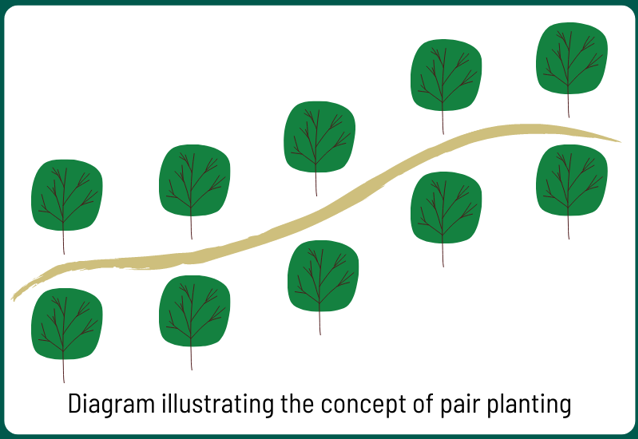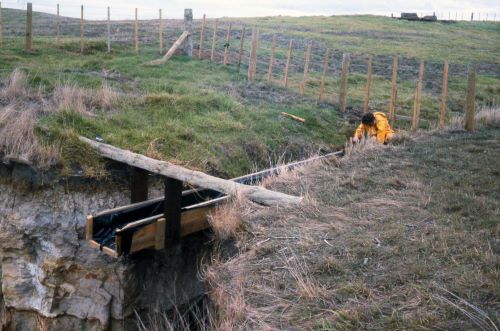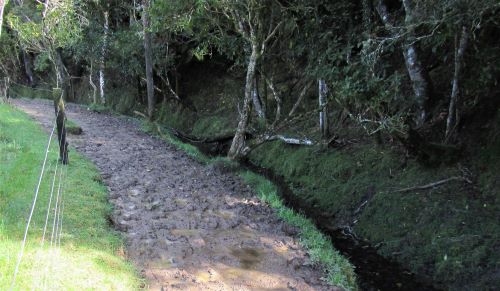Trees for erosion control
Trees planted in the right place stabilise land and prevent erosion by binding the soil and protecting the ground. Good erosion control will help keep valuable soils on your land and out of Northland’s waterways.
It's best to plant before any erosion occurs. After an erosion event it can take up to 20 years for an area to recover, but never to the level of pre-erosion. A little foresight can save a lot of time and effort in the long run, and prevent loss of production.
Grants for soil conservation
There is funding available to support erosion control initiatives on highly-erodible land – find out what funding is available on our “grants for planting on erosion-prone land” page.
Northland Regional Council also provides a limited number of subsidised poplar and willow poles each year – find out more in our poplars and willows section.
Types of erosion
There are six main types of erosion, each of which needs a slightly different approach to manage:
- Gully erosion
- Stream bank and river erosion
- Wind erosion
- Sheet erosion
- Slope instability – slips, slumps, earthflows
- Tomo or tunnel gully erosion.
Gully erosion
Gullies only carry water for short periods during, or immediately after, heavy rain.
Plant gully slopes first as they often trigger other forms of erosion around them.
Treat the cause of the gully erosion if possible – for example, fencing out stock or diverting water.
Good trees for gully erosion
Willows (Salix spp.) are good in wet areas of gully systems because they form a fibrous mat of roots which protect bare soil from erosion. Willows planted in gullies must be in pairs to confine the water in the channel and prevent scouring of the channel bed.
Poplars are good for stabilising the sides and drier areas of gullies as they have a deep root.

Tree spacing
The bigger the problem, the closer your trees should be planted. For severe erosion, tree pairs should be four to five metres apart. For less severe erosion, tree pairs need only be 10 to 20 metres apart.
Gully heads
Sometimes a gully develops a “head” or pronounced drop as erosion moves upstream.
To protect the vulnerable edge of the drop until planting can stabilise the area, you can build a chute for the water – a flume. When building a flume:
- water should flow through – not around or under – the flume
- it needs to withstand high flows and overflows
- rocks, concrete or a non-erodible material is needed at the bottom of the drop to prevent scouring
- planting is needed around the flume and channel below it to help protect the structure and further prevent erosion.
 Building a flume.
Building a flume.
Streambank and river erosion
It’s important to understand and deal with the causes of streambank and river erosion to make sure your planting is effective – for example, stock contribute to bank instability.
You also need to look at the width of your stream or river and whether flooding is a problem to work out what type of planting to do beside it.
 To be avoided - stock pressure next to a stream.
To be avoided - stock pressure next to a stream.
What to plant where for streambank and river erosion
You’ll need a riparian margin of at least 10 metres to create a self-sustaining piece of bush on the edge of your stream or river.
Trees like puriri and poplars are good for deep stabilisation, and must be planted at least five metres from the top of a steep stream bank.
Having big, heavy trees too close to the bank can eventually cause bank instability, resulting in the trees blocking the waterway and causing flooding. Big trees will need to be pruned to keep the lower branches above flood levels, and may need to be thinned to prevent them from becoming too tall and unstable.
Willows can quickly stabilise stream banks, but their fast growth can end up choking rivers and streams, contributing to flooding and erosion. For advice on planting willows, contact a land management advisor.
Shrub willows can be planted one to two metres from a waterway and smaller native plants are well suited to protecting riparian margins.
For more information on stream bank planting, including a range of suitable species, see our publication Clean Streams – A Guide to Riparian Management in Northland.
Wind erosion
On sandy coastal country and recently cultivated land, managing wind erosion can be complex – talk to one of our land management advisors for specialised technical advice on sand stabilisation and coastal shelter.
Sheet erosion
Sheet erosion (or sheet wash) occurs when water runs off slopes in wide sheets and becomes concentrated into small channels (rills) which can eventually cause gullies.
Sheet erosion can be a problem on cultivated soil or land with open pasture. This can be controlled by establishing a dense vegetative cover such as manuka. Shelter trees can protect the soil and help reduce the drying effects of wind.
Slope instability – slips, slumps, earthflows
There are various ways of dealing with slips, slumps and earth flows, depending on the severity of the problem.
Deal with water problems first
All slope instability is accelerated by water. Deal with water problems first by:
- diverting water coming from above, including road or track run-off
- draining any water ponding on the slope. This may require tapping and piping water away or planting a wet area around any springs
- protecting gullies by planting on or below an eroding area.
Extra planting will be needed to reinforce any water control works.
What to plant and where for slope instability
Retain existing trees that are helping to stabilise the area.
For less severe problems:
- plant poplar or willow poles at 6-10 metre spacings (thin to 10-15 metre spacings once fully grown). These trees will require fencing from stock until well established.
- plant forestry trees at 2-4 metre spacings using species listed in the timber production section. These trees need to be fenced from stock and thinned if grown for timber production.
- plant or encourage the regeneration of native species. Plant at 1-1.5 metre spacings
For more severe problems, one or more of the following options may suit:
- plant with poplar and/or willow stakes at 2-4 metre spacings at the bottom of the slip/slump, and 6-10 metre spacings further up the slope. Fence out stock until trees are well established.
- retire erosion-prone land from grazing for production forestry. These areas will require fencing from stock and suitable species will depend on individual site conditions. Plant at spacings of 2-3 metres at the bottom of the slip/slump, and 6-8 metres further up. Thinning will be needed at some point for production timber.
- retire from production. Plant as above or allow to regenerate in native forest species.
Tunnel gully erosion
Tunnel gullies are formed when soil conditions allow a tunnel to develop below the land surface, which eventually collapses the soil surface, leaving a hole or series of holes down a slope connected by a tunnel. Waiotira clay soils are particularly prone to tunnel gully erosion.
It’s difficult to predict where these holes will develop, but the roots of trees planted along the suspected line of the gully will help bind the soil. Poles should be angled out of the reach of stock or cut longer (four to five metres) to avoid browsing.
Good trees for tunnel gully erosion
Where there is permanent running water, the tunnel gully should be treated as a gully and pair-planted with willows or poplars.
Reducing erosion risk
- When clearing land, reduce erosion risk by leaving native forest on fragile areas and a buffer zone along waterways.
- Cultivating steep slopes can start erosion. To reduce the risk,
- leave drainage depressions uncultivated
- establish vegetation cover over cultivated land as soon as possible
- cultivate along the contour, not up and down the slope
- leave an adequate uncultivated buffer zone with well-established vegetation between cultivated areas. - When constructing tracks, make sure tracks have sufficient cut-offs and culverts to slow water down.
Planting tips
- Plant slips and slumps from the bottom up – most control is achieved in the bottom third of the slip.
- Plantings should extend to solid ground above, below and to the sides of the movement.
- Where trees are planted directly on to slip faces, the site should be fertilised with slow-release reactive rock phosphate.
- Don’t plant in cracks in the ground, as these will dry out and open during summer. If the crack is forming into a tomo, plant into it and monitor progression.
- Complete fencing before planting to protect the plants from goats, horses, cattle and sheep.
- When planting poles, plant into damper depressions where water accumulates rather than hard slip faces, and avoid stock tracks or compacted soils. This will greatly assist survival over the first couple of seasons.
- Plant poles deeply (at least 0.75 metres in depth) and ram well. Driving poles into the ground gives better survival rates.
- If grazing is to continue as trees grow and mature, some trees may need to be thinned to prevent the canopy closing over and creating bare areas through shading.
- For native plant cover, the main objective is to get quick canopy closure to exclude weeds and promote fast plant growth.
